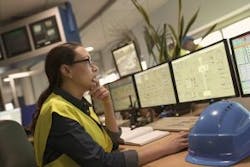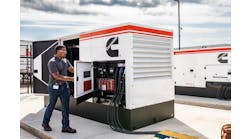A quick glance at the headlines or evening news makes it clear that extreme weather events caused by climate change are becoming more frequent, often causing widespread power disruptions or long-term outages. Integrated hybrid energy systems, where renewable and traditional generation, energy conversion and storage technologies are combined, can help increase the resiliency and reliability of the grid while maintaining a cost-effective, balanced clean electricity supply.
Innovative hybrid hydroelectric plants help drive the power industry’s progress toward net-zero targets. Run-of-the-river hydropower, coupled with battery energy storage systems, further extends the benefits of renewable water power, helping global communities meet their climate and sustainability goals while reliably providing clean energy to their citizens. Another hybrid example, adding floating solar panels to hydroreservoirs, creates a virtual battery that delivers solar power during the day while balancing the grid with hydropower during off-peak hours.
Recent real-world projects demonstrate the feasibility and advantages of coupling run-of-the-river hydroplants with battery energy storage systems.
In spring 2021, I was among a team of Emerson hydropower experts that helped lead a series of tests of a run-of-the-river hydropower plant and battery energy storage system on the Snake River for Idaho Falls Power, in a collaboration with Idaho National Laboratory. A sweeping three-hour blackout in December 2013 brought on by extreme winter weather conditions led Idaho Falls Power to seek black start capabilities to keep essential local community services operating during larger grid blackouts. A project in the works since 2015, last spring’s tests established one of the world’s first water-powered microgrids.
During the tests, automation configurations for two of Idaho Falls Power’s power plants were adjusted. The tests were a success with the power system, including supercapacitor and high-energy power banks, matching demand. Idaho Falls Power has reliably provided its customers with hydropower for nearly a century, and the results of this pilot proved it can continue to serve the city of Idaho Falls’ most critical infrastructure when disconnected from the power grid.
Similarly, the small remote town of Cordova, Alaska, has coupled lithium-ion (Li-ion) battery energy storage with its hydropower microgrid to recover lost hydrogeneration while also reducing its use of diesel generators. Cordova has no connection to the larger, interconnected grid, so it must rely on two run-of-the-river hydropower plants and a backup diesel generation plant. The town’s diesel generation is used when rivers freeze in the winter and to help meet peak demand in the summer with fees that can exceed its hydrogeneration costs by 10 times, making the need to transition even more urgent. Because of the Li-ion storage capacity, Cordova has been able to offset its usage of diesel generation in favor of cleaner, cost-effective hydropower.
It’s clear the future of renewable energy is hybrid, pairing clean generation with long-term storage capabilities to both remove dependence on traditional fossil fuel generation and support communities during emergency events by keeping essential services running. An integrated automation platform can play an important role in helping organizations operate microgrids more efficiently and reliably.
Scalable software and automation technologies, such as Emerson’s Ovation, integrate battery energy management and hydroplant management into one platform. Providing greater visibility through a single, unified view of operations eliminates data silos, complexity and risk. This translates into enhanced reliability and cost-effective operations while providing a pathway to add innovative software easily and economically for remote operations and data analytics.
Matt Roberts is director of renewable projects at Emerson.









